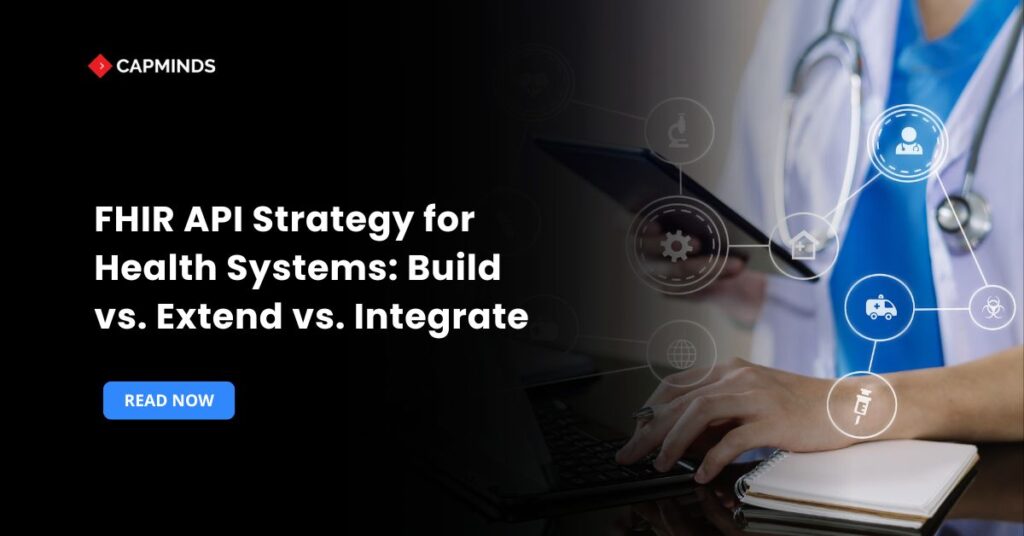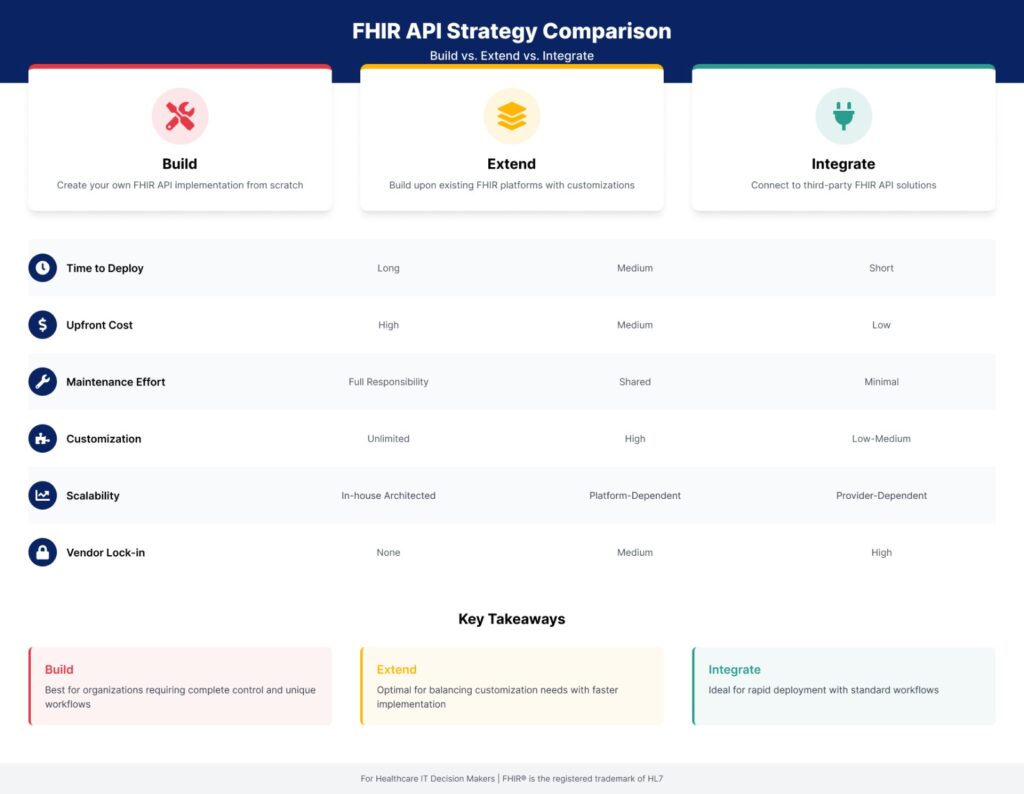FHIR API Strategy for Health Systems: Build vs. Extend vs. Integrate
Healthcare organizations upgrade their IT ecosystems, and using the HL7 FHIR standard for APIs has become critical. However, selecting whether to create, expand, or integrate an FHIR-based system might be challenging.
Each solution has unique benefits and trade-offs in terms of speed to market, cost, flexibility, and long-term maintenance. In this blog, you’ll learn;
- Whether to “build,” “extend,” and “integrate” in the FHIR.
- Key benefits and limitations of each technique
- Scenarios best suited to each method
- A decision framework to guide your decision
1. Build A Custom FHIR API Solution
Health systems have the greatest control and flexibility when they create their own FHIR API solution from the ground up. Creating a custom FHIR-compliant API that fits the organization’s particular needs and existing infrastructure is the goal of this approach.
Benefits of Creating from Scratch:
- Complete control over operation and features.
- Integrate seamlessly with current systems and workflows.
- Ability to prioritize and deploy certain FHIR resources.
- Potential for novel solutions beyond traditional FHIR implementations
- No need for third-party vendors or license fees.
Timeline Considerations
The process of developing a customized FHIR API solution is often time-consuming. The project’s size and complexity will determine the timeline, but health systems can expect:
- 3-6 months for the basic planning and design.
- 6-12 months for core development and testing.
- 2-3 months for integration and implementation.
- Continuous development and maintenance.
Customization Possibilities
Building from scratch provides limitless customization opportunities. Healthcare systems can:
- Implement FHIR resources and profiles that are relevant to their needs.
- Create custom extensions to meet particular data requirements.
- Design customized processes and business logic.
- Create specific security and access restrictions.
- Integrate with proprietary systems and databases.
Maintenance
While tailored systems provide the greatest control, they also need extensive continuing maintenance:
- Regular upgrades to ensure FHIR compliance as standards develop.
- Continuous security patching and vulnerability management.
- Performance optimization and scalability enhancements
- Bug fixes and feature improvements
- Documentation updates and developer support
Health systems must be prepared to spend resources for long-term maintenance and upgrades in order to keep the custom FHIR API solution functional, secure, and compliant over time.
Related: Achieving Interoperability at Scale: HL7, FHIR, and API Integrations with OpenEMR
2. Extend an Existing FHIR Platform
Extending an existing FHIR platform entails taking a pre-built FHIR server, whether open-source, commercial, or embedded within an EHR and customizing it to fit specific organizational requirements. This method enables health systems to build on a solid basis while adding specific functionality as needed.
Advantages of Extending an Existing Solution
- Using a ready-made FHIR infrastructure allows for a faster time to market.
- Reduced development time since basic FHIR compliance and resource management are pre-built.
- The ability to add custom modules, extensions, or business logic.
- Vendor support and regular upgrades for commercial systems.
- Lower beginning expenditures compared to starting from scratch.
Timeline Considerations
Extending an existing FHIR solution considerably shortens the initial development time. Healthcare systems can usually be expected.
- 1-2 months for solution evaluation and customization planning.
- Extension creation, integration, and testing take around 3-4 months.
- 1-2 months for deployment and fine-tuning.
- Minor updates and enhancements will continue as needed.
Customization
While not as infinite as starting from scratch, expanding a platform provides significant flexibility.
- Create customized FHIR profiles and resource extensions.
- Implement custom validation rules or authorization procedures.
- Connect to mobile apps, patient portals, and legacy systems.
- Modify user interfaces or reporting layers based on FHIR data.
- Add organization-specific search and filtering features.
Maintenance
Extending a platform involves shared maintenance tasks between the health system and the platform provider.
- The core platform is periodically upgraded to newer FHIR versions.
- Maintaining custom extensions to guarantee compatibility.
- Security upgrades and compliance with changing requirements.
- Performance adjusting as usage increases.
- User support, documentation, and training for internal teams.
This technique strikes a compromise between the advantages of quick deployment and the opportunity to customize where it matters most, all while limiting the costs associated with complete platform ownership.
FHIR API Strategy Comparison
3. Integrate with Third-Party FHIR Services
Integrating with external FHIR services entails using FHIR APIs supplied by third-party vendors such as EHR providers, HIE, or cloud-based FHIR services, rather than maintaining or constructing an FHIR server internally.
Advantages of Integrating With Third-Party Services
- Rapid deployment with minimum infrastructure configuration.
- The supplier handles hosting, security, and upgrades, so there is little initial commitment.
- Access to FHIR endpoints that have been pre-validated and scaled.
- Prioritize application layer and user experience over backend complexity.
- Pay-as-you-go strategies lessen financial risk while providing predictable charges.
Timeline Considerations
Integration initiatives can be completed quickly based on vendor readiness and internal application development deadlines.
- It takes 2-4 weeks to pick a provider, sign a contract, and configure first access.
- Integration, development, testing, and deployment take around 1-3 months.
- Light maintenance is performed continuously in response to vendor API updates or business demands.
Possibilities of Customization
Because the main FHIR services are external, customization occurs mostly at the application or presentation layer.
- Create patient or provider applications that use the external FHIR APIs.
- Create middleware to combine data from several FHIR sources.
- Rather than on the FHIR server, implement organization-specific logic in the client application.
- Add custom security layers on top of third-party endpoints.
- Use FHIR data streams to build dashboards, portals, and analytics.
Maintenance
Integration initiatives delegate the majority of the heavy lifting to a third-party vendor, but certain internal duties remain.
- Monitoring and maintaining vendor service level agreements and uptime.
- Keeping up with any version updates to the external FHIR API.
- Maintain compliance with data privacy and security standards.
- Maintaining your applications, middleware, and display layers.
- Plan your budget for regular subscription or transaction costs.
This strategy is appropriate for health systems seeking a cost-effective, quick, and low-maintenance solution that does not require significant technical investment in FHIR infrastructure.
Comparison – Build Vs Extend Vs Integrate
| Criteria | Build | Extend | Integrate |
| Time to Deploy | Long (6–12+ months) | Moderate (3–6 months) | Short (weeks–months) |
| Upfront Cost | High | Medium | Low |
| Maintenance Effort | Full responsibility | Shared (core vs. extensions) | Minimal for Core Interoperability |
| Customization | Unlimited | High | Low – Medium |
| Scalability | Architected in‑house | Depends on Platform | Depends on Provider |
| Vendor Lock‑in | None | Medium | High |
Decision Framework
1. Evaluate your In-House Expertise
- Do you have FHIR developers, architects, or DevOps capabilities?
- Building may lead to long-term distinctiveness.
- If not, expansion or integration keeps up without requiring significant initial expenditure.
2. Define your Time Horizon
- Is there a crucial date, like a product launch or a regulatory requirement?
- If integration or expansion is necessary for short-term objectives, take into account a phased building strategy.
3. Map Your Customization Needs
- Are you familiar with a vendor’s data model and extension mechanisms?
- If your processes need innovative FHIR transactions or odd data models, a build or deep extension strategy is recommended.
4. Evaluate the Total Cost of Ownership
- Include license, hosting, developer wages, training, and upgrade cycles.
- A hosted integration solution may reduce TCO at the price of control.
5. Plan for Governance and Compliance
- Who will handle FHIR version upgrades, security fixes, and compliance testing?
- Shared duties change significantly between “build your own” and “use someone else’s.”
Related: 10 Things to Consider for Deploying a FHIR Server in Healthcare Networks
Simplify FHIR Implementation with CapMinds Expertise
At CapMinds, we understand that every healthcare organization has unique goals and constraints when implementing FHIR.
Whether you’re building from scratch, extending an existing FHIR platform, or integrating with third-party services, we’re your trusted partner in navigating every path.
Our FHIR-focused digital health tech services include:
- End-to-end Custom FHIR API Development
- HL7 FHIR Integration Services
- Smart FHIR API Strategy & Architecture Consulting
- FHIR Platform Extension and Custom Module Development
- Interoperability Solutions using RESTful APIs
- Compliance-ready Secure API Deployment & Maintenance
From accelerating your time-to-market to scaling with confidence, CapMinds helps healthcare organizations build robust, future-ready FHIR infrastructures that empower better patient care and data accessibility.
Contact CapMinds today to discuss your FHIR strategy. Let us help you build, extend, or integrate the right solution tailored to your vision.





